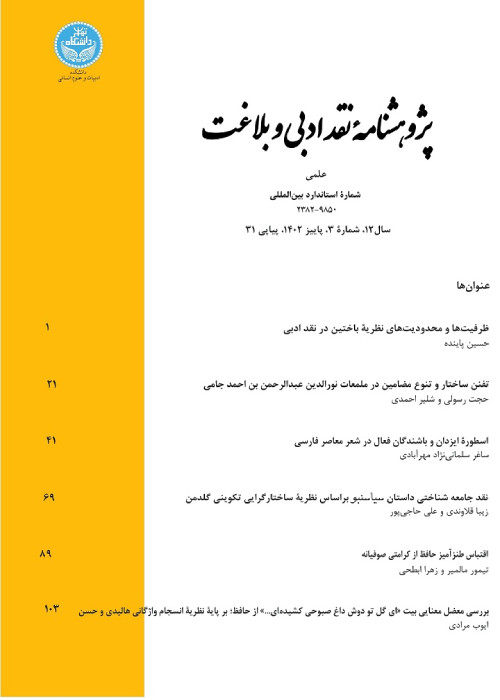Rebirth in the Stories of “The Companions of the Cave”, “Younes” and “The Meeting of Khedr and Moses” based on the Literary School of Symbolism
Author(s):
Article Type:
Research/Original Article (دارای رتبه معتبر)
Abstract:
This article discusses the definition of the school of symbolism, transcendental symbolism in which objective images are symbols of ideal and cosmological thoughts and feelings, and connect the material and immaterial worlds. Arabic is referred to as “allegory” and in English as “symbolism”. But it seems to be seen as a new language. Evidence of its newness, its revision - though not in the sense of its new use as a language - and the lack of a clear and concise definition - at least on the basis of a not-so-distant author's research - of this language suggests that religion is this style. Speech is a well-known hypothesis in the literature of various lands, including poetry and prose. Relying on a descriptive-analytical method, the author has tried to open new windows to the meanings of the stories of the Companions of the Cave, Younes, and Khedr and Moses, without intending to compare the word of God with the works of human theological art. The characteristics of text independence, attention to the audience, and self-reference are explained in the Qur'an and the school of symbolism, and by examining the symbols in these three stories, such as prayer, water, fish and whale, etc., and numbers such as three, four. , seven, and nine, and the use of these numbers in the story and theatrical construction of the three stories, addressing the concept of rebirth (rebirth is one of the basic human beliefs) and attention to the meaning of the symbol that Jung describes as something vague and unknown or secretly knows us. The symbol, in addition to its obvious and common meaning, also contains rays of other concepts. And it occurs when it is necessary to express a purpose that the thought can not bring to the realm of thought has been extracted and addressed.
Keywords:
Language:
Persian
Published:
Journal of Literary Criticism and Rhetoric, Volume:11 Issue: 1, 2022
Pages:
1 to 19
magiran.com/p2498834
دانلود و مطالعه متن این مقاله با یکی از روشهای زیر امکان پذیر است:
اشتراک شخصی
با عضویت و پرداخت آنلاین حق اشتراک یکساله به مبلغ 1,390,000ريال میتوانید 70 عنوان مطلب دانلود کنید!
اشتراک سازمانی
به کتابخانه دانشگاه یا محل کار خود پیشنهاد کنید تا اشتراک سازمانی این پایگاه را برای دسترسی نامحدود همه کاربران به متن مطالب تهیه نمایند!
توجه!
- حق عضویت دریافتی صرف حمایت از نشریات عضو و نگهداری، تکمیل و توسعه مگیران میشود.
- پرداخت حق اشتراک و دانلود مقالات اجازه بازنشر آن در سایر رسانههای چاپی و دیجیتال را به کاربر نمیدهد.
In order to view content subscription is required
Personal subscription
Subscribe magiran.com for 70 € euros via PayPal and download 70 articles during a year.
Organization subscription
Please contact us to subscribe your university or library for unlimited access!


